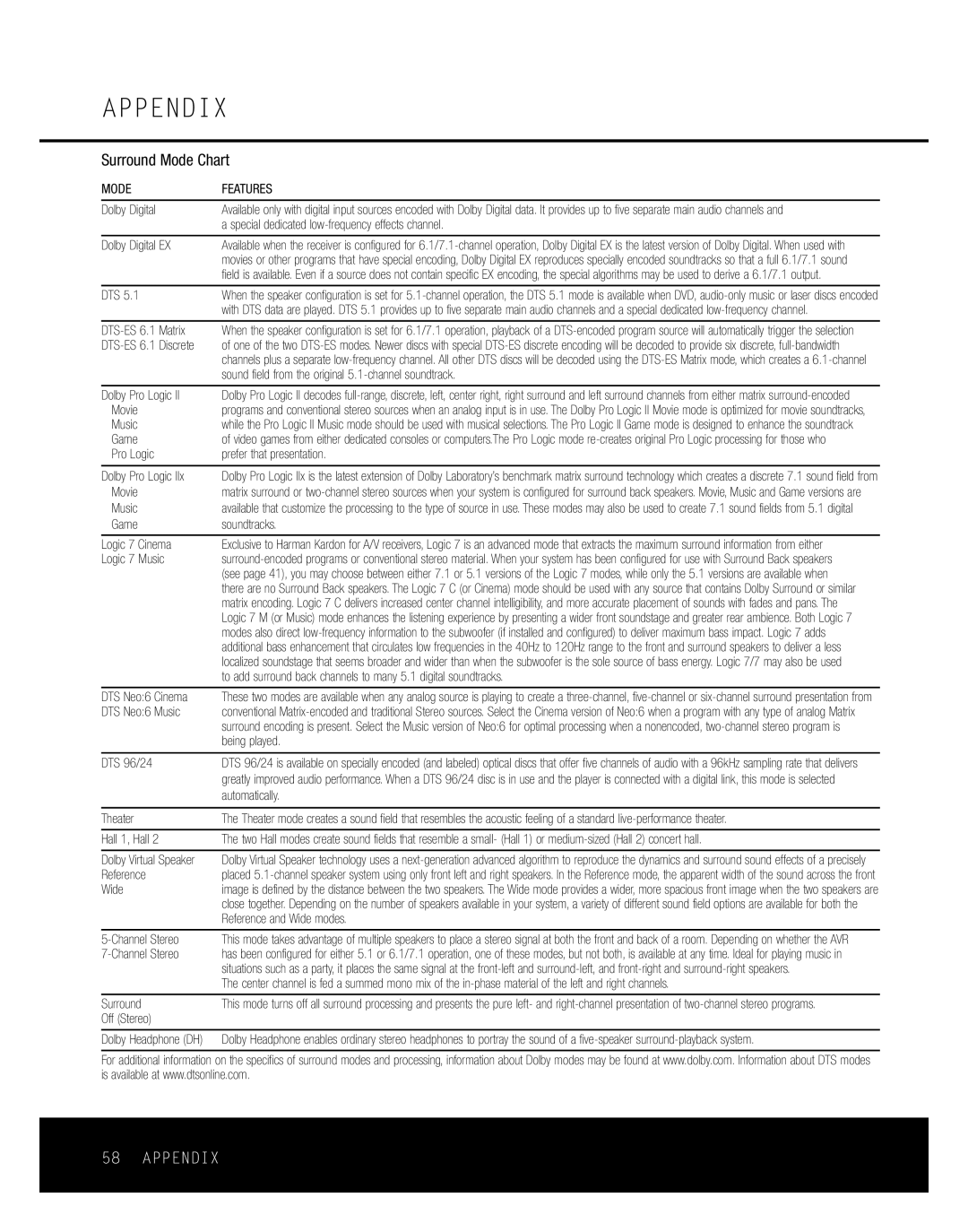
APPENDIX
Surround Mode Chart
MODE | FEATURES |
Dolby Digital | Available only with digital input sources encoded with Dolby Digital data. It provides up to five separate main audio channels and |
| a special dedicated |
|
|
Dolby Digital EX | Available when the receiver is configured for |
| movies or other programs that have special encoding, Dolby Digital EX reproduces specially encoded soundtracks so that a full 6.1/7.1 sound |
| field is available. Even if a source does not contain specific EX encoding, the special algorithms may be used to derive a 6.1/7.1 output. |
|
|
DTS 5.1 | When the speaker configuration is set for |
| with DTS data are played. DTS 5.1 provides up to five separate main audio channels and a special dedicated |
|
|
| When the speaker configuration is set for 6.1/7.1 operation, playback of a |
| of one of the two |
| channels plus a separate |
| sound field from the original |
|
|
Dolby Pro Logic II | Dolby Pro Logic II decodes |
Movie | programs and conventional stereo sources when an analog input is in use. The Dolby Pro Logic II Movie mode is optimized for movie soundtracks, |
Music | while the Pro Logic II Music mode should be used with musical selections. The Pro Logic II Game mode is designed to enhance the soundtrack |
Game | of video games from either dedicated consoles or computers.The Pro Logic mode |
Pro Logic | prefer that presentation. |
|
|
Dolby Pro Logic IIx | Dolby Pro Logic IIx is the latest extension of Dolby Laboratory’s benchmark matrix surround technology which creates a discrete 7.1 sound field from |
Movie | matrix surround or |
Music | available that customize the processing to the type of source in use. These modes may also be used to create 7.1 sound fields from 5.1 digital |
Game | soundtracks. |
|
|
Logic 7 Cinema | Exclusive to Harman Kardon for A/V receivers, Logic 7 is an advanced mode that extracts the maximum surround information from either |
Logic 7 Music | |
| (see page 41), you may choose between either 7.1 or 5.1 versions of the Logic 7 modes, while only the 5.1 versions are available when |
| there are no Surround Back speakers. The Logic 7 C (or Cinema) mode should be used with any source that contains Dolby Surround or similar |
| matrix encoding. Logic 7 C delivers increased center channel intelligibility, and more accurate placement of sounds with fades and pans. The |
| Logic 7 M (or Music) mode enhances the listening experience by presenting a wider front soundstage and greater rear ambience. Both Logic 7 |
| modes also direct |
| additional bass enhancement that circulates low frequencies in the 40Hz to 120Hz range to the front and surround speakers to deliver a less |
| localized soundstage that seems broader and wider than when the subwoofer is the sole source of bass energy. Logic 7/7 may also be used |
| to add surround back channels to many 5.1 digital soundtracks. |
|
|
DTS Neo:6 Cinema | These two modes are available when any analog source is playing to create a |
DTS Neo:6 Music | conventional |
| surround encoding is present. Select the Music version of Neo:6 for optimal processing when a nonencoded, |
| being played. |
|
|
DTS 96/24 | DTS 96/24 is available on specially encoded (and labeled) optical discs that offer five channels of audio with a 96kHz sampling rate that delivers |
| greatly improved audio performance. When a DTS 96/24 disc is in use and the player is connected with a digital link, this mode is selected |
| automatically. |
|
|
Theater | The Theater mode creates a sound field that resembles the acoustic feeling of a standard |
|
|
Hall 1, Hall 2 | The two Hall modes create sound fields that resemble a small- (Hall 1) or |
|
|
Dolby Virtual Speaker | Dolby Virtual Speaker technology uses a |
Reference | placed |
Wide | image is defined by the distance between the two speakers. The Wide mode provides a wider, more spacious front image when the two speakers are |
| close together. Depending on the number of speakers available in your system, a variety of different sound field options are available for both the |
| Reference and Wide modes. |
|
|
| This mode takes advantage of multiple speakers to place a stereo signal at both the front and back of a room. Depending on whether the AVR |
has been configured for either 5.1 or 6.1/7.1 operation, one of these modes, but not both, is available at any time. Ideal for playing music in | |
| situations such as a party, it places the same signal at the |
| The center channel is fed a summed mono mix of the |
|
|
Surround | This mode turns off all surround processing and presents the pure left- and |
Off (Stereo) |
|
|
|
Dolby Headphone (DH) | Dolby Headphone enables ordinary stereo headphones to portray the sound of a |
For additional information on the specifics of surround modes and processing, information about Dolby modes may be found at www.dolby.com. Information about DTS modes is available at www.dtsonline.com.
58 APPENDIX
